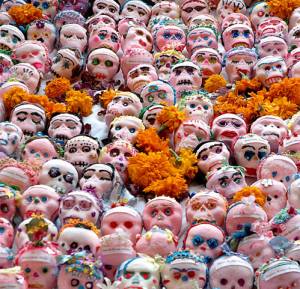How I Discovered Día De Los Muertos
 In my own life, growing up between Los Angeles and South Texas, celebrating Día de los Muertos was always almost just a shadow on the wall that was pretty easy to miss. A few extra prayers in front of a family photo. A glass of water and some chocolates in the fireplace, next to a placement of portraits. Reminiscing about those who were no longer with us, a bit more than usual. A conversation about death, “We’re all going to die one day, baby.”
In my own life, growing up between Los Angeles and South Texas, celebrating Día de los Muertos was always almost just a shadow on the wall that was pretty easy to miss. A few extra prayers in front of a family photo. A glass of water and some chocolates in the fireplace, next to a placement of portraits. Reminiscing about those who were no longer with us, a bit more than usual. A conversation about death, “We’re all going to die one day, baby.”
And because I grew up with a bunch of non-Mexican Latinos, in the Latinized city of Los Angeles, Día de los Muertos always appeared to us as a series of news reports about community festivals and university celebrations, and perhaps even a slice of a lesson in public school. Skulls. Skeletons. Cool.
But it was not until I actually began to lose people in my life — my grandfather, my friend — that the essence of this celebration became real to me. Once someone passes, you are never the same, and remembering them becomes the only way you are still able to access them, or the person you were when they were with you. Honoring your dead — whether it’s by creating an elaborate altar (at the fireplace as we did) or just glancing at their photos, saying a prayer, remembering that, as my abuelito would say, “Recordar es vivir” (to remember is to live) — is actually just another way to celebrate life. Because, as I was told when I was younger, we’re all headed there eventually, baby.
Once this became clear to me, I found myself picking up the same imperceptible habits that I saw growing up. Putting down a mantel or toallita (mat or doily), moving my family photos into one place, adding a few personal objects that reminded me of those I love. Water, flowers, food. Prayer.
What’s perhaps the most amazing to me is how subtle the holiday is in my family, as opposed to the huge and bright celebrations of Janitzio that most think of as the “standard” of Día de los Muertos. Most people I grew up with had their own version of the celebration, too: a family trip to the cemetery, an altar at the house, baking, church. But the point is, however people chose to physically celebrate this holiday, whether it’s as elaborate as Janitzio or as simple as a paryer, its essence remains the same.
Día de los Muertos has become, for me, a celebration of my life and all the wonderful people — living and dead — with whom I get to share it. And while it may sometimes seem like an odd way to appreciate life, but turning your thoughts to death, I’ve found that it’s actually quite comforting and is what feels right to me. Perhaps it’s not as flashy as sugar skulls and paper-mache, it’s my own little version of this celebration that fits for me. Although, I have to admit, skulls are still pretty cool.
[Photo By Glen’s Pics]
